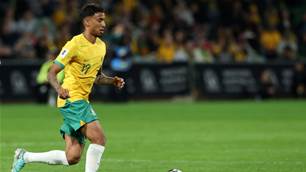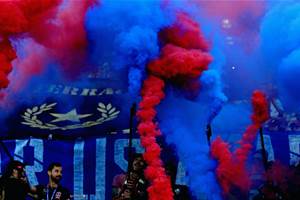The likes of Aaron Mooy and Tom Rogic already earn millions of dollars per season in Europe, so why is Asia so alluring?
When Europe's best footballers move to Asian leagues in the peak of their careers, the same two major questions often arise from fans:
1. Why are they willing to sacrifice playing at the highest level for more money when they're already (let's be honest) filthy rich?
2. Why are they leaving in the peak of their careers, rather than waiting until they're bedraggled has-beens on a victory lap?
The first question plays a little into human psychology but the second question is based on objective facts, so we'll answer that first.
FIRST, A LITTLE CONTEXT
Australians are used to fringe Socceroos heading to Asian leagues all the time: Mitch Duke moved from Western Sydney Wanderers to Al Taawoun only a couple of weeks ago.
It's easy to understand because even when these players have European offers, they're rarely secure and their playing wages in Europe aren't enough to sustain their retirement.
But when Australia's most famous export, 29-year-old Aaron Mooy, leaves a regular starting position in the English Premier League to sign an $18 million contract with Shanghai SIPG, it beckons a few questions.
Especially given only a few years ago, Tim Cahill waited until he was nearly 36 to move to the same city and he was reportedly earning higher wages then, than Mooy is now.
These questions are dominating this transfer window given strong rumours that the second most famous Aussie export, Tom Rogic, is on the verge of an $8 million move to Qatar. We should note that while this isn't confirmed, it is reminiscent of a wider trend.

SO, WHY GO IN YOUR PEAK?
The truth is, Mooy and Rogic may not have as many choices as you might think.
The competition for places in Europe's biggest leagues is rising exponentially. The smaller clubs are increasing spending on their own academies as high wages and transfer fees shut them out of the market, while the bigger clubs are increasingly influenced by the growing flood of players from Africa and South America.
In the midst of a transfer bubble - where players are vastly overvalued - and a global pandemic playing havoc with owner's bottom lines, even Australia's best footballers abroad are little fish in big ponds.
European and Asian leagues are increasingly a two-way market, with players going to Asia younger, then returning to European clubs after a one or two-year spell. Leaving the European market, given its current situation, and returning in a year or two is actually a reasonably sensible decision.
But it's not just Europe that's more competitive.
The up-and-coming Asian leagues - specifically the major Middle Eastern competitions and the Chinese Super League - are now more competitive than ever.
The days of 37-year-old has-beens earning $100,000 per week are already gone. Nowadays, if middle-tier stars like Mooy and Rogic wish to earn big bucks at big Asian clubs, they have to move younger than ever.
KEY PHRASE: BIG CLUBS
When famous players go to Asian markets, they want to sign for major, proven clubs. Clubs that have renowned coaches, a lack of owner interference and secure financial backers...which are definitely not a given.
Most importantly, they need clubs that are located in cities that can provide a familiar lifestyle.
Tim Cahill gave an insight into why he specifically signed for Shanghai Shenhua after leaving New York Red Bulls, citing the standard of living in Shanghai as miles above that found in the smaller, lesser-known Chinese cities.
Given the relative political and economic stability in mainland China and Qatar compared to many other countries in Asia and the Middle East, the truly enticing options are narrower than many believe.
Thus, the competition further increases. Those relatively few cities in Asia where livability for westerners (especially with a young family, as virtually all these players have) can match their club's pay packet are becoming harder to earn a place at.
If you look at the visa spots on most Chinese Super League or Qatari Stars League clubs, you'll actually find that Mooy and Rogic aren't particularly big names for these clubs. Former EPL players abound at virtually every one.
But what works in Australia's favour is that mandatory AFC spots for each Asian club make the likes of Mooy and Rogic prime candidates. They also inflate the wage costs for Australian players, putting more money in Aussie pockets.
But this still doesn't answer the major question:
WHY DOES THE EXTRA MONEY MATTER?
Put yourself in Mooy's shoes for a minute:
You love your job, but you've been doing it for a long time and it's physically and mentally exhausting. You're beginning to think about the end of your career and feel like you've proved everything that you're likely to prove.
Meanwhile, there are a dozen other teammates fighting you every single day for your role. Brighton said themselves that they have many players as good as Mooy in Mooy's position.
Someone comes along and offers you everything that you love about your job - high-level football, packed stadiums, massive star potential - but without any of your current concerns.
No competition for your place, no mental exhaustion worrying about your future. No real prospect of relegation or coaching swaps or unrelenting media pressure. No paparazzi tracking your every move. An end to the unending speculation.
An end to all that and hell, they'll pay you twice as much for the privilege. Why wouldn't Mooy and Rogic cash in on big-money Asian moves?

THE ASIAN QUALITY MYTH BUSTED
First things first, unlike many other nations gunning for the 2022 World Cup, Rogic and Mooy are effectively guaranteed a place in Australia's squad.
The Socceroos just don't have the midfield depth to challenge them, so they can happily play in Asian leagues and still consider their spot on the plane to Qatar (well, Rogic might just have to walk) as safe as can be.
But even if Australia did have the depth playing in Europe, it probably wouldn't matter.
Take Brazil's Oscar for example. He wasn't Brazil's best player, then he went to Shanghai, then he was called up to the Brazilian national team - one of the best teams in the world - on the strength of his form in the Chinese Super League.
To anyone who's still doubtful, the biggest clubs in China and Qatar aren't just a lot better than they used to be, they're as good - if not considerably better - than the best clubs in Japan and South Korea and rivalling bigger clubs in Europe.
All the evidence: friendly matches, Asian Champions League, continental results, even national team results (Qatar winning the last Asian Cup) backs this up.
Celtic just went out of the Champions League in the third qualifying round to Hungarian club Ferencvaros. Last season they went out in the third qualifying round to Romanian club CFR Cluj.
Just because they're British and have a proud history doesn't mean they're better than the better clubs from minnow European nations. So why on earth would they be that much better than some of the richest clubs in the world?
In Asia, the coaching and facilities are better at the biggest Asian clubs as well. Are Neil Lennon or Graham Potter better than Shanghai boss Vitor Pereira? Pereira's managed bigger clubs in bigger leagues and won far more trophies, so probably not.
All of this just means that Rogic and Mooy aren't going to get worse playing at these clubs.
They join safe in the knowledge that if they continue to work as hard as they have been, they'll continue to play at basically the same level when called up to the national team.
STANDARDS ACROSS THE LEAGUE
They may not raise themselves to a higher level constantly playing against the world's best, but they will train alongside the world's best.
Mooy will team up with Hulk, Oscar and Marko Arnautovic - among others - at SIPG, players who would still walk into Brighton's lineup.
The standard of player and coach in the Qatari Stars League is very similar and these leagues (many of which are controlled centrally) are doing an impressive job at spreading talent across each club in the league to enhance the competitiveness.
Not that the Scottish Premier League has been competitive throughout Rogic's tenure, mind you.
But when you look at the players themselves, now in their late 20s, after years of playing at such a high, intensely competitive level, the attraction of not having to constantly worry about your future is so easy for fans to overlook.
Graham Arnold summarised it best when quizzed on Rogic's move to Qatar:
"The competitions in the Middle East are coming on very, very quickly and they're very strong, and with a lot of good players."
"The most important thing for me is that Tommy gets the smile back on his face and the enjoyment back in his game, and that he's also going to play football."
The Socceroos coach wasn't just being diplomatic, he was telling the truth.
People think too often that moves to Asia represent the end of ambition for these players, when it's often anything but. If you can look beyond the scepticism, put aside the Eurosnobbery and ignore the agents chirping in their ears about money, fame and a footballer's feared short careerspan, then you can see there is a lot of substance behind the decisions.
At Shanghai, Mooy will be a far bigger star than he was in England. He'll play alongside bigger stars, he'll play in front of bigger crowds and he'll earn more money. There's a very good chance that he'll enjoy it more as well.
The real question here isn't why the extra money matters, it's why playing in Europe matters.
Related Articles
.jpeg&h=172&w=306&c=1&s=1)
Big change set to give Socceroos star new lease on life in the EPL

Socceroos midfielder embraces move to England















